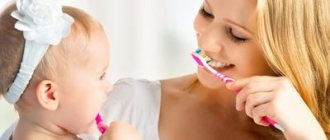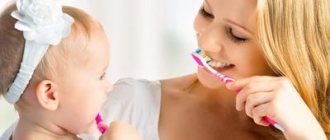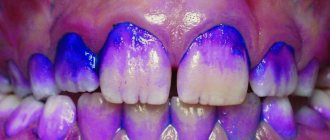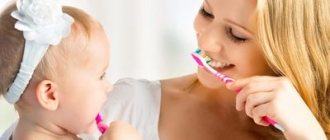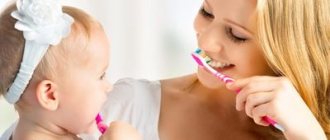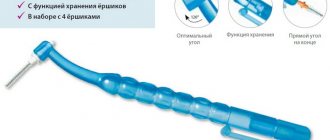Daily oral hygiene is a routine process, brought to the point of “automation”. Often we brush our teeth without thinking about the rules, the position of the brush and the direction of movement. Meanwhile, not only the aesthetic appeal of a smile, but also its health depends on how well oral hygiene is performed. Many dental problems can be avoided (prevented or eliminated) only by following the basic rules of effective teeth brushing.
Improper brushing of teeth
Let's admit it, we brush our teeth automatically. And we often do it wrong: we clean them with movements left and right, sherk-sherk. With this method of cleaning, soft plaque is transferred from the surface of the teeth to the interdental spaces and becomes clogged there. As a result, there is a danger of gum damage and the appearance of a wedge-shaped defect, especially on protruding teeth. A wedge-shaped defect is a lesion of a tooth in the area of contact with the gum. It looks like a step that resembles a wedge. The dimensions can range from barely noticeable to complete chipping in the future.
See what happens when we brush our teeth across their growth:
How to choose a toothbrush
Your dentist's advice will be of great help in choosing a toothbrush.
A soft brush may not clean your teeth as effectively, and hard bristles can damage your enamel and gums. Most often, a medium-hard brush is used. Many people are interested in what is better - an electric brush or an ordinary one. Dentists recommend brushing your teeth with an electric brush no more than 2-3 times a week, because... otherwise the enamel may be damaged. Good reviews about ultrasonic brushes. They allow you to remove plaque in hard-to-reach places due to ultrasonic vibrations that lift plaque from the surface. Recommended for sensitive teeth, braces, periodontal diseases, and other situations where mechanical cleaning is difficult. However, the peculiarities of such brushes are their rather high cost, as well as the presence of contraindications - for cancer patients, people with cardiovascular diseases, mental illnesses, pacemakers and children under 9 years old.
Standard method of brushing teeth Pakhomova G.N.
This method is recommended by most Russian dentists. It was invented by G.N. Pakhomov - professor of dentistry.
- Cleaning begins from the upper jaw in the following order - from the right molars to the front ones, then finishes on the left molars.
- On the lower jaw, the left major ones are cleaned first, then the anterior ones, and lastly the right molars.
- The front and back surfaces are cleaned with sweeping movements from bottom to top, with the brush head at an angle of 45° to the gum.
- It is important to make 10 movements for each tooth.
- Contaminants from the chewing side are removed by moving the head back and forth.
- To clean the front teeth, the brush is placed vertically and moved in a sweeping motion.
The Pakhomov method helps to effectively clean the oral cavity, but for the interdental spaces additional means are needed - irrigators, threads and a tongue scraper.
How to brush your teeth correctly?
There are other methods of brushing teeth: the Leonard method, the Reite method, the Bass method, the Smith-Bell method, the Stillman method, the Fones method, the Charter method. Each of these methods is selected taking into account the condition of the teeth and periodontium. For example, for gingivitis during puberty, it is recommended to use gentle teeth brushing techniques, which include the Charter and Bass method.
How to brush your teeth - The Charter Method
The method is used to clean teeth and gums, and to massage the gums. In this case, the toothbrush is positioned so that the bristles are at an angle of 45 degrees to the gingival margin. Without removing the bristles, perform gentle shaking or circular movements, while the bristles penetrate between the teeth.
How to brush your teeth - Bass Method
The brush is placed at an angle of 45 degrees to the tooth axis, their ends partially penetrate the gingival groove and interdental spaces. The brush moves vibrating forward and backward.
These two methods help clean the gingival grooves, interdental spaces and contact surfaces of the teeth.
How to brush your teeth - The Leonard Method
It is performed using a brush, which is placed perpendicular to the surface of the teeth, making only perpendicular movements in the direction from the gums to the crown.
How to brush your teeth - Reite Method
With the Reite method, the bristles are placed parallel to the axis of the tooth, performing rolling movements from the gums to the crown.
How to brush your teeth - Smith-Bell Method
With this method of brushing teeth, the movements of the brush follow the path of food during chewing. The brush is placed perpendicular to the chewing surface and in this position, with gentle pressure and rotation, is advanced to the gum.
How to brush your teeth - The Stillman Method
The method is performed by pressing on the gingival margin with a brush using weak rotational movements. The bristles are installed so that their ends partially lie at an angle to the axis of the tooth, and partially on the gum.
Assistive methods for brushing with a toothbrush
Fones method
It belongs to the American dentist Alfred Fones, who is considered one of the founders of hygienic dentistry. The method is suitable for adults, children and people who do not have periodontal disease.
- To clean the external surfaces, the teeth are closed and the bristles of the brush are placed perpendicular to the surface. The brush head makes circles while simultaneously capturing the teeth of both jaws and the adjacent gums.
- The same movements are performed to clean the internal surfaces (separately for the upper and lower jaws).
- Chewing surfaces are also cleaned using circular movements.
Pros:
good gum massage.
Bass method
The method involves cleaning and massaging the gums with vibrating movements, and cleaning the chewing surfaces with horizontal movements. Advantages:
The method is suitable for cleaning teeth with exposed roots. You can only use a soft brush.
Additional methods of brushing teeth with a manual brush
The following two assistive techniques for brushing teeth are the most common:
Bass method
The peculiarity of this method is that it is suitable for cleaning teeth with open (exposed) root areas. The method provides not only cleaning of the teeth, but also massage of the gums.
The implementation of this technique provides for the following rules:
- The toothbrush must be held horizontally, at an angle of 45° to the surface of the tooth. In this case, half of the fibers of the toothbrush should extend beyond the gums.
- Cleaning is carried out first in a circular motion, then sweeping (from the gum to the edge of the tooth).
- To clean the internal surfaces and back (molars) teeth, the position of the brush changes to vertical.
- Cleaning the oral (palatal) and vestibular (external, from the lips and cheeks) surfaces of the tooth is performed with vibrating movements without moving the ends of the bristles.
- Chewing surfaces are cleaned with horizontal back-and-forth movements.
It is important to note that you should only use a soft toothbrush for this method.
BRUSH SELECTION
For children over one year old, it is important to choose the right toothbrush; it must meet the following requirements:
- presence of a limiter on the handle;
- rubber fluffs.
After 3 years, you can switch to classic models with short handles and soft bristles, the working surface is no more than 2.5 cm. It is desirable to have silicone inserts on the handle, they will help prevent the “tool” from slipping in an unsure child’s palm. When the paste is used, you can consider options in which the area on the bristles is highlighted in color for the placement of the paste.
How to use an electric toothbrush
Believe it or not, many schoolchildren are now excited about brushing their teeth, a daily dental care ritual. We can thank the invention of the electric toothbrush for this phenomenon.
Electric brushes are easy to use, and this is one of their advantages. And although an electric toothbrush costs more than a regular toothbrush, it is worth it if your child (or you) is more enthusiastic about using it for oral health, as it can improve your oral health. Most electric toothbrushes work anywhere from 5,000 to 30,000 strokes per minute, and because of this, a thorough brushing takes less time. Some electric toothbrushes are even more powerful - Oral B's Professional Care 7000 series rotates 40,000 times per minute.
To learn more…
To use an electric toothbrush, simply squeeze a little toothpaste onto the brush head and hold it at a 45-degree angle, just like a regular brush. Then turn on the brush and move the bristles from tooth to tooth. Typically, small brush heads clean one tooth at a time, depending on the size of your teeth. Guide the brush along the front, back, and chewing surfaces of each tooth. Even with an electric toothbrush, you'll have to spend about two minutes brushing to make sure you've brushed every tooth. After cleaning, simply rinse the attachment with water and let it dry.
People with healthy periodontal disease are recommended to brush their teeth using the standard brushing method twice a day (in the morning after breakfast and at night). With the standard method of brushing teeth, the dentition is conventionally divided into 6 segments (molar group, premolar group and frontal group). Teeth begin to be brushed from the left molars of the upper jaw towards the center. First on the upper jaw, then on the lower jaw. The dentition is open.
Algorithm for the standard method of brushing teeth 1. Divide the dentition into several segments: molars, premolars, front teeth. 2. Place the brush at an angle of 45 degrees to the surface of the teeth (dentitions are open). 3. Brush the teeth from the vestibular surface of the upper jaw on the left, performing 10 sweeping movements from top to bottom with the brush, then move on to all other segments. 4. Brush the teeth from the palatal surface of the upper teeth, moving in segments from left to right, making 10 sweeping movements on each one. 5. Brush the teeth of the lower jaw in the same sequence. 6. Brush all surfaces of the teeth with brush movements back and forth, 10 movements per surface. 7. Finish brushing your teeth with circular movements along the vestibular surface, grasping the teeth and gums.
Notes
When performing sweeping movements with a brush, it is first placed at an acute angle from the surface to be cleaned, and then the brush is turned along its axis.
During reciprocating movements, the brush is placed perpendicular to the surface to be cleaned.
On the upper jaw, when cleaning the palatal surface of the front teeth, the toothbrush is placed with the handle down, and on the lower jaw, when cleaning the lingual surface, it is positioned upward. If the sequence of movements with a toothbrush is violated, plaque can be transferred to the interdental spaces.
There are other methods of brushing teeth: the Leonard method, the Reite method, the Bass method, the Smith-Bell method, the Stillman method, the Fones method, the Charter method.
Each of these methods is selected taking into account the condition of the teeth and periodontium. For example, for gingivitis during puberty, it is recommended to use gentle teeth brushing techniques, which include the Charter and Bass method. Charter method. The method is used to clean teeth and gums, and to massage the gums.
In this case, the toothbrush is positioned so that the bristles are at an angle of 45 degrees to the gingival margin. Without removing the bristles, perform gentle shaking or circular movements, while the bristles penetrate between the teeth.
Bass method. The brush is placed at an angle of 45 degrees to the tooth axis, their ends partially penetrate the gingival groove and interdental spaces. Brush movements vibrate back and forth. These two methods help clean the gingival grooves, interdental spaces and contact surfaces of the teeth.
Leonard's method. It is performed using a brush, which is placed perpendicular to the surface of the teeth, making only perpendicular movements in the direction from the gums to the crown.
Reite's method. With the Reite method, the bristles are placed parallel to the axis of the tooth, performing rolling movements from the gums to the crown.
Smith-Bell method. With this method of brushing teeth, the movements of the brush follow the path of food during chewing. The brush is placed perpendicular to the chewing surface and in this position, with gentle pressure and rotation, is advanced to the gum.
Stillman method. The method is performed by pressing on the gingival margin with a brush using weak rotational movements. The bristles are installed so that their ends partially lie at an angle to the axis of the tooth, and partially on the gum.
Fones method. When performing this method of brushing teeth, the bristles are placed perpendicular to the vestibular surface of the tooth, the dentition is closed, and they are cleaned in a circular motion.
Important to remember!
- The tooth has five surfaces, and the brush processes only three of them. Therefore, in addition to a toothbrush, it is necessary to use interdental floss and interdental brushes daily to clean the lateral surfaces of the teeth.
- Don't forget to brush your tongue. To do this, you can use the back of a brush or a special scraper.
- Remember! Regular and thorough dental care is an important part of caring for the health of the whole body.
Take care of your teeth and smile!
Choosing a toothpaste
The paste should also be used taking into account the oral condition of each person.
One has sensitive teeth - a special toothpaste is needed to reduce sensitivity. Another has such microflora in his mouth that plaque builds up very quickly - he needs an antibacterial one. In the third case, there may be bleeding gums - a paste is needed for gum health. Very often all this can be combined, then a combined action paste is needed. When choosing a paste manufacturer, you must also focus on your feelings. After all, it is very important that brushing your teeth is comfortable, and if the taste of the toothpaste causes nausea, a person is unlikely to benefit from it. It happens that, apparently due to the individual characteristics of the oral microflora, after brushing your teeth with certain pastes, after some time a film forms on the oral mucosa, which creates discomfort. In this case, it is better to replace the paste.
Many people want to make their teeth lighter and for this they constantly use whitening toothpastes. Here you need to know that modern whitening pastes most often contain enzymes that facilitate easier removal of plaque. Although these pastes do not harm the enamel, they can only be used daily for 1-2 months. Highly abrasive whitening toothpastes (used mainly for smokers) are more effective, but also dangerous to the enamel. They can only be used 1-2 times a week.
Bass method
The head of the brush with bristles is positioned at an angle of 45 degrees to the axis of the tooth, slightly pressing the ends of the bristles to the enamel and gum. Thus, the fibers penetrate into the gingival groove and interdental spaces. It is important to maintain the correct position of the brush head, because... Vertically positioned bristles damage the epithelial attachment and gingiva.
Cleaning the labial (cheek) and oral surfaces of the teeth is done with vibrating movements with a small amplitude. Chewing surfaces are cleaned with back and forth movements. This method allows you to thoroughly clean the cervical area of the molars.
Professional cleaning
Professional hygiene is performed by a doctor in a clinical setting. Advantages of the procedure:
- Effective removal of contaminants - plaque and stone.
- Using ultrasound, stone is removed from the sub- and supragingival spaces.
- Cleaning gum pockets.
- Polishing the enamel with a special paste.
- The enamel is also coated with varnish, a fluoridating compound that nourishes the dental tissue. This is required to prevent oral pathologies.
- After the procedure, the enamel becomes lighter.
In addition to ultrasound, Air-flow devices are used for professional cleaning, the action of which is based on the action of soda, water and air. A high-pressure jet from the device cleans teeth, but this method is suitable for soft stains.
Professional cleaning is suitable for persons over 16 years of age. Contraindications include arrhythmias, tuberculosis, hepatitis, HIV, ARVI.
